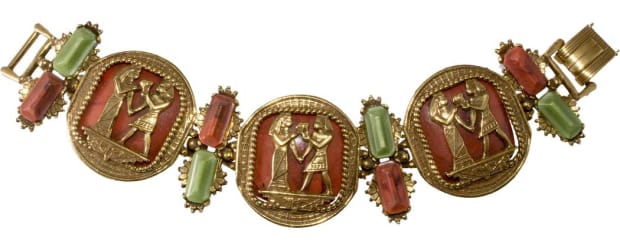#Celebrating #Egyptian #Revival #Jewelry #Anniversary #King #Tut039s #Tomb
The opening of King Tut’s tomb 100 years ago sparked a fascination with all things Egyptian, including Egyptian Revival jewelry. Costume jewelry expert Pamela Wiggins Siegel examines pieces dating from the early 19th century through the 1970s.
As history marks a century since King Tut’s tomb was opened by British archaeologist Howard Carter in 1923, it’s a perfect time to explore the topic of Egyptian Revival jewelry. The globally publicized event sparked a renewed interest in Egyptian motifs over the remainder of the 1920s and into the early 1930s. That wasn’t the first instance of ancient treasures from Egypt inspiring jewelers, however, nor would it be the last.
THE ROOTS OF A REVIVAL
Ancient Egyptian jewelry – donned for adornment, power, and as amulets by both the living and in the afterlife – has widely been studied by scholars and archeologists. Most of those pieces reside in museums now. Fortunately, though, the numerous collectors seeking the look of the pharaohs can hunt down Egyptian Revival jewelry pieces dating from the early 19th century through the 1970s.
The rebirth of these designs came about in the early 1800s as the field of Egyptology expanded. Napoleon’s invasion of Egypt and Syria spurred great interest, particularly in France. As more and more texts and exhibitions featured the treasures of ancient Egypt, artisans around the world were inspired to interpret related motifs into an array of decorative arts, including jewelry.
Many recognizable fine jewelers like Boucheron, Marcus & Co., and Castellani incorporated Egyptian styles into their collections from the mid- to late-1800s, as noted by Antique Jewelry University. Interest in related motifs remained steady through the Victorian era and carried over into early the 20th century in both fine and costume jewelry.
JEWELRY FROM EARLY 1900S
More artifacts gleaned from temples and tombs kept Egyptomania alive during the early 1900s. In 1909, The Illustrated London News featured jewelry that had been enclosed in Queen Tauosrit’s tomb millennia ago. The discovery of the bust of Nefertiti offered new imagery to inspire artists and jewelers several years later. Tiffany & Co.’s Favrile glass scarabs are one example of how jewelers were inspired by these treasures during the 1910s.
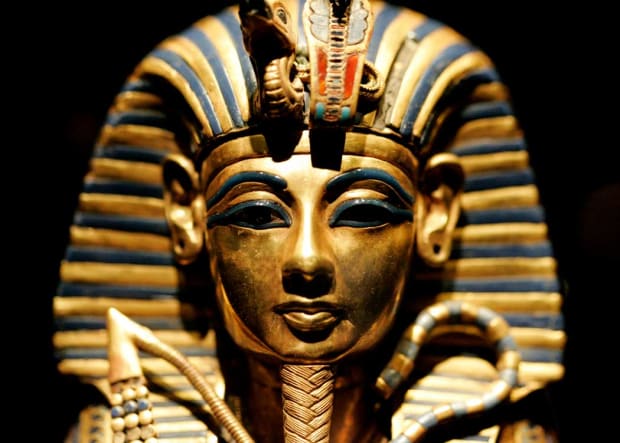
As the news of Carter’s discovery of Tutankhamen’s tomb in 1922 and the subsequent opening in 1923 spread, the Boy King’s likeness garnered attention the world over. Fine jewelers like Cartier and Van Cleef & Arpels made their own interpretations of Egyptian Revival adornment with Art Deco influences. Many of these were laden with colored gemstones and diamonds.
The imagery of ancient Egypt was incorporated into silver and costume jewelry as well. It was common for visitors to Egypt to bring home souvenirs with related motifs in the designs. This includes bracelets featuring everything from hieroglyphics to profiles of Nefertiti in the designs.
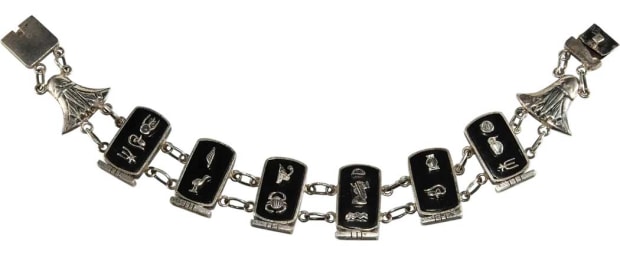
Some costume jewelry pieces were decorated with elements that were popular during the period including peacock eye glass, colorful molded glass beads, and carved stone. Enameling and glass cabochon accent stones were also used to impart the rich reds, blues, and greens associated with ancient Egyptian jewelry.
Today, some of the costlier pieces of Egyptian Revival costume jewelry from this period are Neiger Brothers pieces. These are hard to find and usually sell in the hundreds when sold by knowledgeable dealers. Take care in buying jewelry purported to be Neiger, however, since many pieces are misidentified or misrepresented in the collector’s marketplace.
1970s DESIGNS
The popularity of Egyptian Revival designs waned going into the World War II years and for several decades to follow. There were select pieces of jewelry made from the 1940s through the early 1970s with Egyptian influences, though. Joseff of Hollywood made jewelry for Cleopatra starring Elizabeth Taylor in 1963.
Napier introduced its “Egyptian Collection” in the early 1970s. The bigger push in jewelry production during the mid-1970s, however, was once again related to King Tut.
The epic museum exhibit “Treasures of Tutankhamun” toured the United States from 1976 through 1979. Literally millions of people lined up in six cities across the country to see these artifacts. A new generation of jewelry designers and craftsmen were inspired by them. Some of most notable styles were Lawrence Vrba’s crowning achievement as head designer for Miriam Haskell. His popular designs featured in Newsweek magazine in 1976 were a complete departure from the company’s usual faux pearl jewelry.
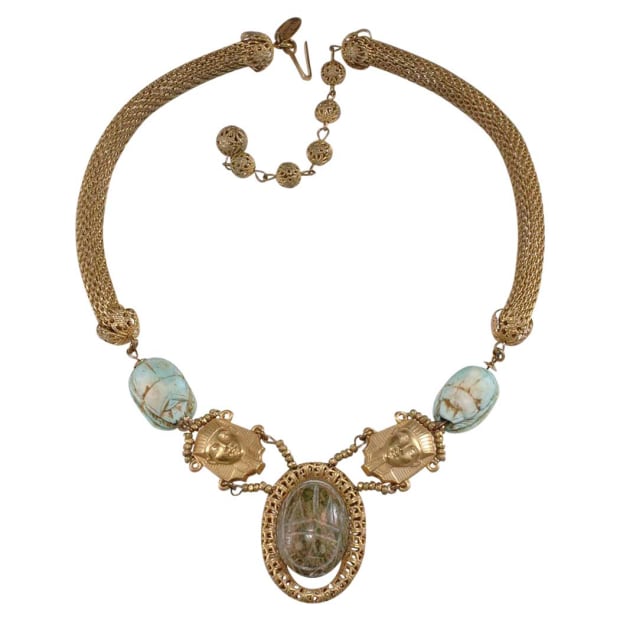
Other costume jewelry companies produced Egyptian Revival jewelry in the mid-1970s as well. Among these are a brightly colored enamel collection by Hattie Carnegie and all-metal styles by ART.
While King Tut’s relics have toured America since then, none of those exhibitions have had the marked effect on jewelry design and production akin to the fashionable fanfare of the mid-1970s. Nevertheless, costume jewelry marketers including Joseff of Hollywood, Vrba under his own brand, and Avon designs by Elizabeth Taylor have incorporated Egyptian-inspired elements and styles since then.
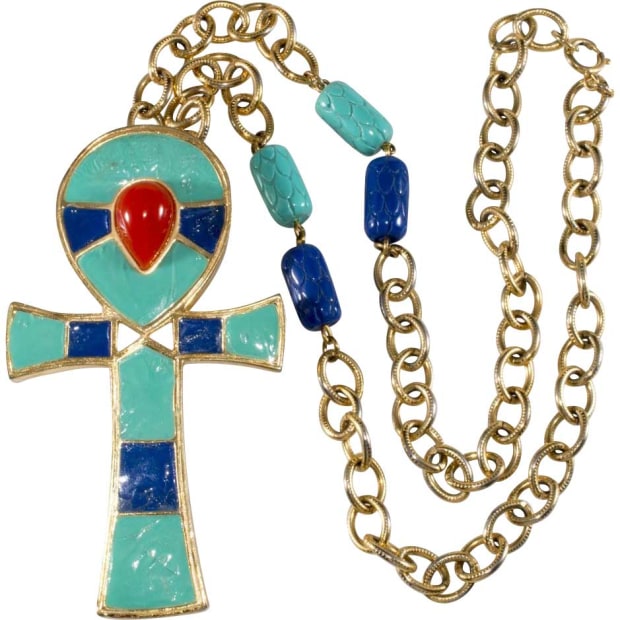
JEWELRY MOTIFS
The representations of animals, people, and symbols used to embellish Egyptian Revival jewelry are often what make them so attractive to collectors. Regardless of the age, there are several motifs you’ll find repeatedly in these designs.
One of the most frequently used elements is the scarab, a type of beetle. For ancient Egyptians, they stood for rebirth and renewal. They’ve been made from every substance imaginable including molded glass, ceramics, carved gemstones, plastics, and enameling. Some older jewelry pieces even have actual insects mounted in metal settings. These bright green bugs can be mistaken for other materials at first glance. Taking a closer look, each one is a bit different in shape and size.
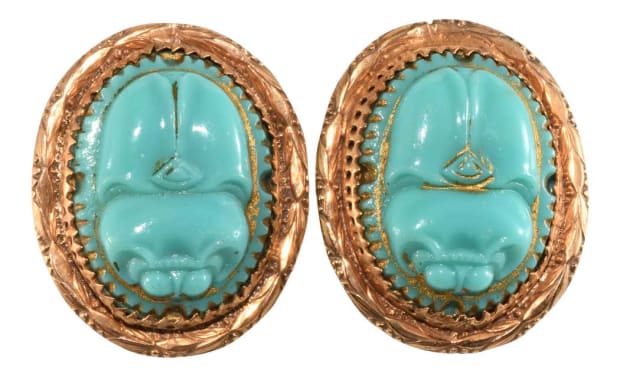
Other animals range from falcons, as seen in the god Horus – a human with a falcon’s head – to sleek felines. Cats made their way into illustrations of deities, too, since they were looked upon as magical representations of power and fertility. The vulture Nekhbet was a symbol of protection in Upper Egypt and a cobra goddess served the same purpose in Lower Egypt. All these motifs have been represented in Egyptian Revival jewelry.
When thinking about people depicted in this type of adornment, King Tut and Nefertiti usually come to mind the most often. King Tut’s death mask has been reproduced in many pendant designs although some feature his entire sarcophagus. Nefertiti, with her unmistakable flat-topped headdress, has also been featured in many jewelry designs. Generic images of ancient Egyptians, including more nondescript pharaohs, have made their way into jewelry during the 20th century as well.
The Egyptian symbol of life – the ankh – has also frequently been incorporated in revival adornment. Hieroglyphics, pyramids, lotus flowers, and other symbols of Egyptian culture can also be present in jewelry designs of all ages.
LEARNING MORE
There are many museum catalogs and books referencing ancient Egyptian jewelry available through local libraries and online booksellers. As for books relating to collectibles, Egyptian Revival Jewelry & Design (Schiffer Books) by Dale Reeves Nicholls, Shelly Foote, and Robin Allison is a title still in print. In terms of antique fine jewelry, a visit to the Antique Jewelry University website offers a glimpse at a number of remarkable pieces gleaned from high-end auction catalogs.
You May Also Like:
Miriam Haskell Made Costume Jewelry for the Stars
Hattie Carnegie Quirky Costume Jewelry Delights

